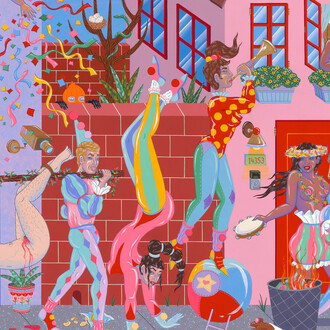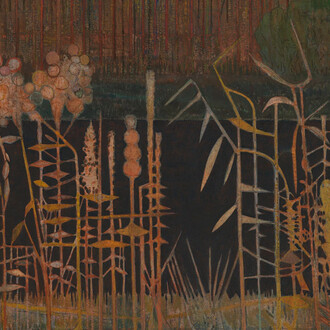Intersections: Caribbean and Brazilian Art from the Permanent Collection illustrates the diversity of artworks created about and throughout the greater Caribbean and Brazil, and it demonstrates the many ways in which artists of the African diaspora record their histories and represent their cultures. Not only do these works feature an array of media such as painting, photography and sculpture; their content is equally varied, ranging from rural landscapes to abstract watercolors to black-and-white portraits. They display the breadth and depth of the diasporic experience, including the influence of particular communities, a blend of hybrid cultural traditions, and access to different artistic materials and networks.
Haitian artist François Turenne des Pres depict women in his community through lively compositions of females gathering, conversing, and working. Also from Haiti. Hector Hyppolite rendered images of his country’s national history, politics and everyday life using cardboard and natural materials. His works incorporate symbols and imagery related to both Haitian voodoo religion and Christianity, with an emphasis on the vibrancy of the subject matter rather than meticulous execution. Another view of Haiti — although one created from afar — if offered by four of the forty-one scenes of Jacob Lawrence’s print series Toussaint L’Overture, which imparts the history of the leader of the Haitian revolution (1791–1804), considered the most successful revolution carried out by slaves.
Like Lawrence, the Afro-Brazilian painter José Roberto Leonel Barreto is recognized as an artist and an educator. His abstract watercolors, which play with space by juxtaposing bold and translucent shapes in a mix of dense and sparse patterns, reflect his studies, travels and work with his family of artisanal saddlers. In detailed maps by Mexican painter and illustrator Miguel Covarrubias, the viewer is exposed on a miniaturized scale to the landscape, events and people of color of the Caribbean and Mexico. Alongside similarly diverse examples by additional artists, these works offer a window into the history and culture of the people from these regions, and they attest to the influence of the African diaspora throughout the Americas.
















